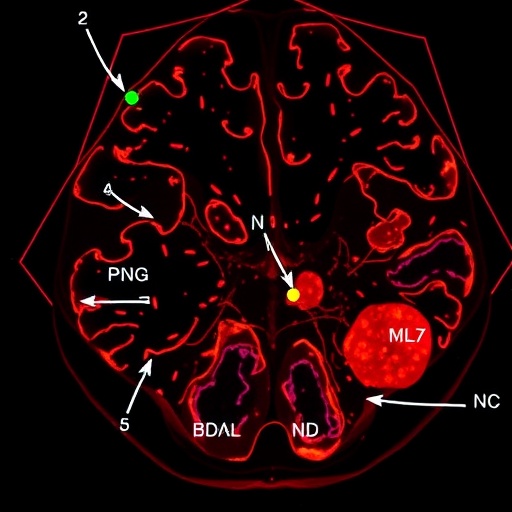
In a pioneering study published recently in Nature Communications, researchers have unveiled a novel epigenetic mechanism that could revolutionize our understanding of intervertebral disc degeneration (IVDD), a leading cause of chronic back pain worldwide. This breakthrough hinges on the intricate molecular interplay between RNA methylation, alternative splicing, and chromatin reprogramming, with the proteins DDX1 and MATR3 at the center of the biological drama. The team, led by Zhu, D., Liang, H., and Tong, B., has demonstrated how DDX1 methylation influences MATR3 splicing, subsequently triggering chromatin remodeling events that drive the pathological changes observed in degenerative disc disease.
Intervertebral discs are fibrocartilaginous structures that act as crucial shock absorbers between the vertebrae of the spine. Over time, these discs can deteriorate, leading to debilitating pain and loss of mobility in millions of individuals globally. While prior research has identified some genetic and environmental contributors to IVDD, the precise molecular drivers remained shrouded in complexity. This study marks a major leap forward by revealing a previously uncharacterized epigenetic axis that translates post-transcriptional RNA modifications into genome-wide chromatin state alterations, culminating in disc degeneration.
Central to these findings is the RNA helicase DDX1, a protein traditionally known for its involvement in RNA processing and transport. Zhu and colleagues discovered that DDX1 undergoes methylation, a chemical modification that alters its activity and interaction profile. This methylation event was found to selectively regulate the splicing patterns of MATR3, a multifunctional nuclear matrix protein intricately involved in RNA binding and splicing regulation. By influencing MATR3’s isoform expression, DDX1 methylation effectively rewires the post-transcriptional landscape within nucleus pulposus cells—the key cell type populating intervertebral discs.
.adsslot_biwlQVYSPA{width:728px !important;height:90px !important;}
@media(max-width:1199px){ .adsslot_biwlQVYSPA{width:468px !important;height:60px !important;}
}
@media(max-width:767px){ .adsslot_biwlQVYSPA{width:320px !important;height:50px !important;}
}
ADVERTISEMENT
Changes in MATR3 splicing have profound downstream consequences. The study reveals that altered MATR3 variants orchestrate a reprogramming of chromatin architecture by recruiting specific epigenetic modifiers. This reprogramming leads to widespread changes in chromatin accessibility and histone modifications across the genome, reshaping the transcriptional outputs critical for maintaining disc matrix homeostasis. Disruption of this finely tuned epigenetic circuitry results in the expression of catabolic enzymes and inflammatory mediators, driving extracellular matrix breakdown and cellular senescence characteristic of degenerative disc disease.
Remarkably, the investigators employed integrative approaches combining methylome analysis, high-resolution RNA sequencing, and chromatin immunoprecipitation assays to delineate this complex regulatory network. Their meticulous experimental design included patient-derived disc cells and validated animal models, underscoring the physiological relevance and potential translational impact of their discoveries. By linking DDX1 methylation to MATR3-driven chromatin remodeling, this research establishes a direct mechanistic link between RNA modifications and epigenomic changes underpinning IVDD progression.
The therapeutic implications of these findings are significant. Targeting the DDX1-MATR3 axis offers a promising strategy for modulating pathological chromatin states and restoring healthy gene expression profiles in degenerative discs. Pharmacologic modulation of DDX1 methyltransferases or splice variant-specific MATR3 interactions could pave the way for novel disease-modifying treatments. Unlike conventional approaches that often focus on symptom management through pain relief, this epigenetic intervention aims to halt or even reverse the molecular degeneration at its source.
Moreover, this study enriches our broader understanding of how dynamic RNA modifications can instruct chromatin landscapes, a theme gaining momentum in epigenetics. The cross-talk between the epitranscriptome and epigenome exemplified here could extend beyond disc degeneration to other complex diseases where splicing regulation and chromatin state changes play pivotal roles. It opens a new frontier encouraging scientists to explore methylation-induced splicing alterations as potential drivers of pathological chromatin reprogramming in diverse contexts.
This research also highlights the importance of MATR3 as a multifunctional hub integrating RNA metabolism with nuclear organization. Prior to this work, MATR3’s contributions were primarily associated with neuromuscular diseases and neurodegeneration. By identifying its critical involvement in spinal disc pathology, the study expands the functional repertoire of MATR3 and signals that similar molecular mechanisms may underlie degenerative processes across different tissues.
Furthermore, the detailed characterization of DDX1 methylation introduces a nuanced layer of gene regulation. Methylation, an often-studied modification in DNA and histones, is here demonstrated as a pivotal modulator of RNA helicase activity, influencing RNA splicing outcomes with downstream epigenetic implications. This insight advocates for deeper examination of post-translational modifications on RNA-binding proteins and their systemic effects on gene expression and cellular fate decisions.
The interdisciplinary nature of this investigation—interweaving molecular biology, epigenetics, bioinformatics, and clinical research—exemplifies the modern approach necessary to unravel complex diseases. By leveraging advanced sequencing technologies and computational analyses, Zhu and colleagues could dissect multilayered regulatory mechanisms at unprecedented resolution. These integrated methodologies are likely to become standard in epigenomic research, allowing for comprehensive profiling of the noncoding regulatory networks driving human pathologies.
Critically, the study also outlines potential biomarkers derived from the DDX1-MATR3 pathway, which could improve diagnostic precision and patient stratification. Early detection of aberrant methylation or splicing events may identify individuals at risk for rapid disc degeneration, enabling timely therapeutic intervention. Combining biomarker discovery with targeted epigenetic therapies represents a holistic framework for future personalized medicine approaches to spinal degenerative disorders.
The biological insights offered extend toward possible regenerative strategies as well. Understanding how chromatin states can be modulated to favor anabolic over catabolic pathways illuminates new paths for tissue engineering and repair. Manipulating epigenetic regulators involved in the DDX1-MATR3 axis could enhance progenitor cell function or stimulate matrix production, fostering disc regeneration and functional recovery.
Looking ahead, the research community must address remaining questions, such as the upstream signals triggering DDX1 methylation and the exact molecular complexes mediating chromatin reprogramming downstream of MATR3 splice variants. Elucidating these components will be essential to refine therapeutic targets and optimize intervention specificity, minimizing potential off-target effects or toxicity.
Ultimately, the work by Zhu, Liang, Tong, and their collaborators stands as a milestone in epigenetic research focused on musculoskeletal disorders. By illuminating a novel molecular cascade linking RNA methylation to chromatin remodeling in the context of intervertebral disc degeneration, they provide a compelling blueprint for deciphering and combating chronic degenerative diseases. As the global burden of back pain intensifies, such fundamental discoveries carry immense promise to guide innovative treatments and improve quality of life for affected individuals.
This study’s impact resonates beyond spinal health, reflecting the broader significance of RNA epigenetics in regulating chromatin dynamics and disease etiology. It underscores the intricate design of cellular regulatory systems—where modifications at the RNA level reverberate through the genome to shape cellular behavior and fate. It is a testament to the evolving complexity we continue to uncover in biological regulation, inviting deeper exploration and creative therapeutic innovation.
Subject of Research: Intervertebral disc degeneration; RNA methylation; alternative splicing; chromatin reprogramming; DDX1; MATR3
Article Title: DDX1 methylation mediated MATR3 splicing regulates intervertebral disc degeneration by initiating chromatin reprogramming
Article References:
Zhu, D., Liang, H., Tong, B. et al. DDX1 methylation mediated MATR3 splicing regulates intervertebral disc degeneration by initiating chromatin reprogramming. Nat Commun 16, 6153 (2025). https://doi.org/10.1038/s41467-025-61486-7
Image Credits: AI Generated
Tags: alternative splicing in diseasechromatin reprogramming in IVDDchronic back pain mechanismsDDX1 methylationdegenerative disc disease researchepigenetic mechanisms in disc healthfibrocartilaginous structures in spineintervertebral disc degenerationMATR3 splicingmolecular drivers of chronic pain.RNA helicase DDX1 functionRNA methylation and splicing



